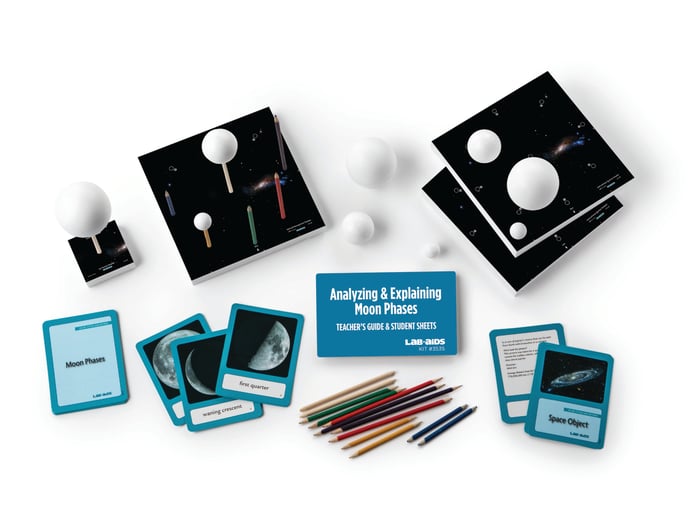Analyzing and Explaining Moon Phases

In the first of the three activities in this kit, students start by ordering the phases of the Moon based on their own experiences and observations of the Moon. They then are challenged to figure out whether there is a predictable, and repeating, pattern in how the Moon's appearance changes over time. Using the pattern they discover, they analyze and interpret data on an incomplete Moon phase calendar and determine which phases occur on the missing days. In Activity 2, students interact with a computer simulation that models the Moon's orbit around Earth. Students record data on how the Moon's appearance changes as its position in its orbit around Earth changes. They then analyze and interpret their data to identify the causes of the cyclic pattern of the Moon's phases. In the final activity, students develop and use a three-dimensional model that illustrates how the Moon's orbital plane is not aligned with Earth's orbital plane around the Sun. This phenomenon explains why there are solar and lunar eclipses a few times a year but not each lunar cycle. This activity also provides an opportunity for students to cement their understanding of the relationship between the Moon's orbit and the cyclical pattern of moon phases.
Details at a Glance
- 3-5 Days | 3-5 ~50 minute class periods
- 3 Activities
- Accommodates unlimited classes, each with 8 groups of 4 students
- All materials are non-consumable
- Developed in partnership with SEPUP
Scientific Concepts
Disciplinary Core Ideas
• MS-ESS1.A
• MS-ESS1.B
Science and Engineering Practices
• Analyzing and Interpreting Data
• Developing and Using Models
Crosscutting Concepts
• Connections to Nature of Science
• Patterns
• Systems and System Models
• Scale, Proportion, and Quantity
• Connections to Engineering, Technology, and Applications of Science
Guides & Student Sheets
Our kits and modules provide you with everything you need so you can open, review, and teach the material confidently the next day.
- Comprehensive Teacher Guide with background information, detailed instruction, example data and answers
- Student Sheets with age appropriate background information, full procedure(s), and analysis items
- Materials necessary for the investigation (beyond common classroom items)
- Safety Data Sheets
Kit Components
- 16 set of eight Moon Phase Cards
- 16 wooden dowel rod
- 16 yellow stick
- 16 green stick
- 16 red stick
- 8 blue stick
- 8 purple stick
- 8 Earth model (2” foam ball)
- 8 Sun model (3” foam ball)
- 8 Moon model (1” foam ball with a hole in it)
- 8 large foam board (8.5” x 8.5” x 1”)
- 8 small foam square (3” x 3” x 1”)
- 8 Earth and Moon Positions Template
